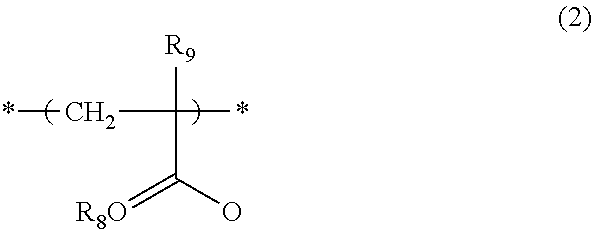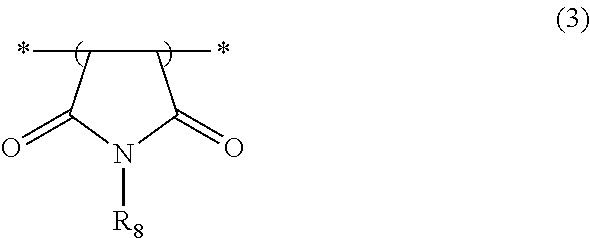Polymeric triarylmethane dye, blue resin composition including for color filter including the polymeric dye and color filter using the resin composition
a technology of polymer and triarylmethane, which is applied in the direction of photomechanical equipment, instruments, originals for photomechanical treatment, etc., can solve the problems of poor economic efficiency, difficult application of dyeing methods to the production of color filters, and inferior dye resistance to external factors, etc., to improve heat resistance and chemical resistance, improve luminance and contrast, and improve the effect of color saturation
- Summary
- Abstract
- Description
- Claims
- Application Information
AI Technical Summary
Benefits of technology
Problems solved by technology
Method used
Image
Examples
example 1
Synthesis of Polymeric Triarylmethane Compounds
[0094]The compounds of Formulae 11, 12, 13, and 14 were chosen as monomeric compounds that can be represented by Formula 6 corresponding to the triarylmethane dye structure represented by Formula 1.
[0095]
[0096]Each of the compounds of Formulae 11, 12, 13, and 14 was polymerized to synthesize a homopolymeric triarylmethane dye.
[0097]At least one compound selected from the group consisting of the monomeric polymerizable compounds of Formulae 7 to 10, which correspond to the structures of Formulae 2 to 5, respectively, was polymerized with at least one compound selected from the group consisting of the compounds of Formulae 11 to 14 to synthesize a copolymeric triarylmethane dye.
[0098]In the following table 1, “a)”, “b)”, “c)”, and “d)” indicate the compounds of Formulae 11, 12, 13, and 14, respectively, and “e)”, “f)”, “g)”, “h)”, “i)”, “j)”, and “k)” belonging to the compounds of Formulae 7 to 10 indicate the following compounds:
[0099]e)...
synthesis example 1
[0106]16.67 g of methyl ethyl ketone was heated to reflux under a nitrogen atmosphere in a 50 mL flask equipped with a reflux condenser. A solution of 3.00 g of the triarylmethane dye compound (c) and 0.48 g of azobisisobutyronitrile (AIBN) as a polymerization initiator in 16.67 g of methyl ethyl ketone was added dropwise to the reaction flask over 2 h. The mixture was refluxed for another 14 h. After completion of the polymerization, the reaction mixture was cooled to room temperature, concentrated under reduced pressure, and dried under vacuum, yielding a polymeric triarylmethane dye having a number average molecular weight of 2210, a weight average molecular weight of 3435, and a dispersity of 1.55.
synthesis example 2
[0107]16.67 g of methyl ethyl ketone was heated to reflux under a nitrogen atmosphere in a 50 mL flask equipped with a reflux condenser. A solution of 3.00 g of the triarylmethane dye compound (a), 0.96 g of 2-ethylhexyl methacrylate (e), 0.96 g of methacrylic acid (f), 0.60 g of N-phenylmaleimide (g), and 0.48 g of azobisisobutyronitrile (AIBN) as a polymerization initiator in 16.67 g of methyl ethyl ketone was added dropwise to the reaction flask over 2 h. The mixture was refluxed for another 14 h. After completion of the polymerization, the reaction mixture was cooled to room temperature, concentrated under reduced pressure, and dried under vacuum, yielding a polymeric triarylmethane dye having a number average molecular weight of 3343, a weight average molecular weight of 7601, and a dispersity of 2.27.
PUM
| Property | Measurement | Unit |
|---|---|---|
| dispersity | aaaaa | aaaaa |
| dispersity | aaaaa | aaaaa |
| thick | aaaaa | aaaaa |
Abstract
Description
Claims
Application Information
 Login to View More
Login to View More - R&D
- Intellectual Property
- Life Sciences
- Materials
- Tech Scout
- Unparalleled Data Quality
- Higher Quality Content
- 60% Fewer Hallucinations
Browse by: Latest US Patents, China's latest patents, Technical Efficacy Thesaurus, Application Domain, Technology Topic, Popular Technical Reports.
© 2025 PatSnap. All rights reserved.Legal|Privacy policy|Modern Slavery Act Transparency Statement|Sitemap|About US| Contact US: help@patsnap.com



